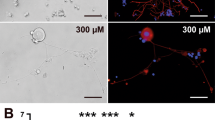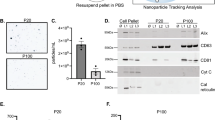Abstract
TREATMENT of neonatal animals with nerve growth factor (NGF) promotes general growth and differentiation of the peripheral sympathetic nervous system. NGF markedly increases the outgrowth of axons and at the same time causes the appearance of many microtubules in electron-microscopic pictures1. Moreover, as a manifestation of enhanced differentiation NGF produces a selective induction of tyrosine hydroxylase (TH) and dopamine β-hydroxylase in sympathetic ganglia2. These two enzymes catalyse key steps in the biosynthesis of noradrenaline and are located selectively in adrenergic neurones3. In contrast, the third enzyme involved in the synthesis of noradrenaline, dopa decarboxylase (DDC), has a more general distribution and is not specifically regulated by NGF2.
This is a preview of subscription content, access via your institution
Access options
Subscribe to this journal
Receive 51 print issues and online access
$199.00 per year
only $3.90 per issue
Buy this article
- Purchase on Springer Link
- Instant access to full article PDF
Prices may be subject to local taxes which are calculated during checkout
Similar content being viewed by others
References
Levi-Montalcini, R., and Angeletti, P. U., Physiol. Rev., 48, 534 (1968).
Thoenen, H., Angeletti, P. U., Levi-Montalcini, R., and Kettler, R., Proc. natn. Acad. Sci. U.S.A., 68, 1598 (1971).
Molinoff, P. B., and Axelrod, J., A. Rev. Biochem., 40, 465 (1971).
Bocchini, V., and Angeletti, P. U., Proc. natn. Acad. Sci. U.S.A., 64, 787 (1969).
Lowry, O. H., Rosebrough, N. J., Farr, A. L., and Randell, R. J., J. boil. Chem., 193, 265 (1951).
Levitt, M., Gibb, J. W., Daly, J. W., Lipton, M., and Udenfriend, S., Biochem. Pharmac., 16, 1313 (1967).
Hakanson, R., and Owman, C., J. Neurochem., 13, 597 (1969).
Oesch, F., Otten, U., and Thoenen, H., J. Neurochem., 20, 16 (1973).
Solomon, F., Monard, D., and Rentsch, M., J. molec. Biol., 78, 569 (1973).
Borisy, G. G., Analyt. Biochem., 50, 373 (1973).
Seeds, N. W., Gilman, A. G., Amang, T., and Nirenberg, M. W., Proc. natn. Acad. Sci. U.S.A., 66, 160 (1970).
Hsie, A. W., and Puck, T. T., Proc. natn Acad. Sci. U.S.A., 68, 358 (1971).
Yamada, K. M., and Wessels, K. N., Expl. Cell Res., 66, 346 (1971).
Angeletti, P. U., Levi-Montalcini, R., and Calissano, P., Adv. Enzymol., 31, 51 (1968).
Monard, D., Solomon, F., Rentsch, M., and Gysin, R., Proc. natn. Acad. Sci. U.S.A., 70, 1894 (1973).
Author information
Authors and Affiliations
Rights and permissions
About this article
Cite this article
STÖCKEL, K., SOLOMON, F., PARAVICINI, U. et al. Dissociation between effects of nerve growth factor on tyrosine hydrolase and tubulin synthesis in sympathetic ganglia. Nature 250, 150–151 (1974). https://doi.org/10.1038/250150a0
Received:
Revised:
Issue Date:
DOI: https://doi.org/10.1038/250150a0
This article is cited by
-
Role of neurotrophin signalling in the differentiation of neurons from dorsal root ganglia and sympathetic ganglia
Cell and Tissue Research (2009)
-
Nerve growth factor modulates tubulin transcript levels in pheochromocytoma PC12 cells
Neurochemical Research (1987)
Comments
By submitting a comment you agree to abide by our Terms and Community Guidelines. If you find something abusive or that does not comply with our terms or guidelines please flag it as inappropriate.



